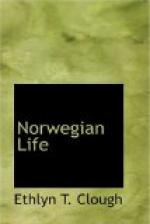Kindness to animals is another virtue of the Norwegian people. Illustrating this trait we again quote William Eleroy Curtis:
“There seems to be a close relation between the human kind and their animals. The men and women talk to the horses and cattle as if they were understood. We had a skydsgut, or driver, one day, who held continuous conversation with his horses. Every time he would come to a hill he would walk beside them and talk to them all the way up in a gentle, caressing sort of way, like a child talking to a doll, and once when he stopped for water and the near horse wanted to drink more than the driver thought was good for him, he scolded like an old woman. The horse shook his head and rattled his harness impatiently, as much as to say, ’You get back onto your box and attend to your business and I’ll attend to mine.’”
That intellectuality is one of the traits of the Swedes and Norwegians alike is evidenced in the long list of names that have become famous in the world’s literature. In spite of the high intellectual attainments of these people, they are fond of the quiet, simple life, with friends and kinsfolk and home employments and home enjoyments. And they are very superstitious, too, and, in spite of their Lutheran faith, they have never discarded the customs that grew from belief in gods many, and fairies, trolls, gnomes and norns without number. The forests, the mountains and gorges, are inhabited by these people still. Nissen is the good fairy of the farmers. He looks after the cattle particularly, and if he is well treated they are healthy, and the cows give lots of milk. To propitiate him it is necessary to put a dish of porridge on the threshold of the cow stable on Christmas morning. Whenever the family move, this invisible being goes along with them and sits on the top of the loads. In haying time he always rides on the load of hay, and the bedstemoder, best mother or grandmother, in every farmhouse can tell the children dozens of interesting stories about the mischief or the kindness of Nissen.
He is invariably represented in pictures of farm life; he appears on the illustrated advertisements of farm machinery; his figure carved in wood is sold at all the curiosity stores, and he appears as a prominent character in most of the fairy stories that deal with farm life. He is represented as a short, fat, bow-legged man, with big whiskers and long white hair, wearing a red hat like those worn by clowns in circuses. He usually appears in his shirt sleeves, with an open collar, a blue vest, and knickerbockers upon his legs, which are as slim as those of a brownie. His circumference is greater than his height, and his head is almost as large as his body.
Noek is the fairy of the waterfalls and is a sort of merman. You never see more than half his body. He is very, very old, his hair and beard are long and white, and his face is always pale and pensive. He carries a harp and plays to amuse the spirits in the waterfall. A statue of Ole Bull has recently been erected in his native city of Bergen. He stands upon a pedestal which rises from a fountain, and the water flows over the head and shoulders of a Noek at the base.




